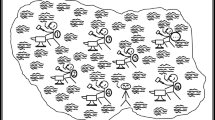Abstract
If artificial organisms are constructed with the goal to better understand the behaviour of real organisms, artificial organisms that resemble human beings should possess a communication system with the same properties of human language. This chapter tries to identify nine such properties and for each of them to describe what has been done and what has to be done. Human language: (1) is made up of signals which are arbitrarily connected to their meanings, (2) has syntax and, more generally, its signals are made up of smaller signals, (3) is culturally transmitted and culturally evolved, (4) is used to communicate with oneself and not only with others, (5) is particularly sophisticated for communicating information about the external environment, (6) uses displaced signals, (7) is intentional and requires recognition of intentions in others, (8) is the product of a complex nervous system, (9) influences human cognition. Communication presupposes a shared worldview which depends on the brain, body, and adaptive pattern of the organisms that want to communicate, and this represents a critical challenge also for communication between robots and us.
Access this chapter
Tax calculation will be finalised at checkout
Purchases are for personal use only
Preview
Unable to display preview. Download preview PDF.
Similar content being viewed by others
References
Boyd, R., & Richerson, P. (1985). Culture and the evolutionary process. Chicago: Chicago University Press.
Di Ferdinando, A., & Parisi, D. (2004). Internal representations of sensory input reflect the motor output with which organisms respond to the input. In A. Carsetti (Ed.), Seeing, thinking and knowing (pp. 115–141). Dordrecht: Kluwer.
Elman, J. L. (1990). Finding structure in time. Cognitive Science, 14, 179–211.
Gallese, V., Keysers, C., & Rizzolatti, G. (2004). A unifying view of the basis of social cognition. Trends in Cognitive Sciences, 8, 396–403.
Hauser, M. D. (1996). The evolution of communication. Cambridge: MIT Press.
Hockett, C. F. (1960). The origin of speech. Scientific American, 203, 88–96.
Mirolli, M., & Parisi, D. (2005a). How can we explain the emergence of a language which benefits the hearer but not the speaker? Connection Science, 17(3–4), 325–341.
Mirolli, M., & Parisi, D. (2005b). Language as an aid to categorization: a neural network model of early language acquisition. In A. Cangelosi, G. Bugmann, & R. Borisyuk (Eds.), Modelling language, cognition and action: proceedings of the 9th neural computation and psychology workshop (pp. 97–106). Singapore: World Scientific.
Mirolli, M., & Parisi, D. (2006). Talking to oneself as a selective pressure for the emergence of language. In A. Cangelosi, A. Smith, & K. Smith (Eds.), The evolution of language: proceedings of the 6th international conference on the evolution of language (pp. 214–221). Singapore: World Scientific.
Mirolli, M., & Parisi, D. (2009). Towards a Vygotskyan cognitive robotics: the role of language as a cognitive tool. New Ideas in Psychology. doi:10.1016/j.newideapsych.2009.07.001, ISSN 0732-118X, http://www.sciencedirect.com/science/article/B6VD4-4X00P73-1/2/5eb2e93d3fc615eea3ec0f637af6fc89
Parisi, D. (1983). A three-stage model of language evolution: from pantomime to syntax. In E. De Grolier (Ed.), Glossogenetics: the origins and the evolution of language (pp. 419–434). Paris: Harwood Academic.
Parisi, D. (2004). Internal robotics. Connection Science, 16(4), 325–338.
Parisi, D. (2007). Mental robotics. In A. Chella & R. Manzotti (Eds.), Artificial consciousness (pp. 191–211). New York: Imprint Academic.
Schlesinger, M., & Parisi, D. (2001). Multimodal control of reaching: simulating the role of tactile feedback. IEEE Transactions on Evolutionary Computation, 5, 122–128.
Simon, H. A. (1990). A mechanism for social selection and successful altruism. Science, 250, 1665–1668.
Steels, L. (2003). Language-reentrance and the ‘inner voice’. Journal of Consciousness Studies, 10(4–5), 173–185.
Steels, L., & Wellens, P. (2006). How grammar emerges to dampen combinatorial search in parsing. In P. Vogt, Y. Sugita, E. Tuci, & C. Nehaniv (Eds.), Third international symposium on the emergence and evolution of linguistic communication (EELC) (pp. 76–88). Berlin: Springer.
Strawson, P. (1959). Individuals. London: Methuen.
Tomasello, M. (2008). Origins of human communication. Cambridge: MIT Press.
Vygotsky, L. S. (1962). Thought and language. Cambridge: MIT Press.
Wray, A. (Ed.) (2002). The transition to language. Oxford: Oxford University Press.
Author information
Authors and Affiliations
Corresponding author
Editor information
Editors and Affiliations
Rights and permissions
Copyright information
© 2010 Springer-Verlag Berlin Heidelberg
About this chapter
Cite this chapter
Parisi, D. (2010). Artificial Organisms with Human Language. In: Nolfi, S., Mirolli, M. (eds) Evolution of Communication and Language in Embodied Agents. Springer, Berlin, Heidelberg. https://doi.org/10.1007/978-3-642-01250-1_2
Download citation
DOI: https://doi.org/10.1007/978-3-642-01250-1_2
Published:
Publisher Name: Springer, Berlin, Heidelberg
Print ISBN: 978-3-642-01249-5
Online ISBN: 978-3-642-01250-1
eBook Packages: Computer ScienceComputer Science (R0)




